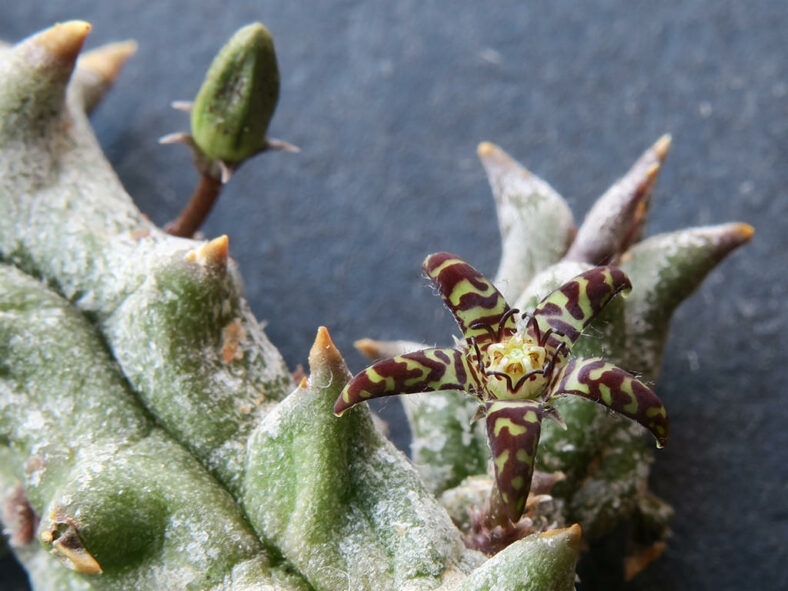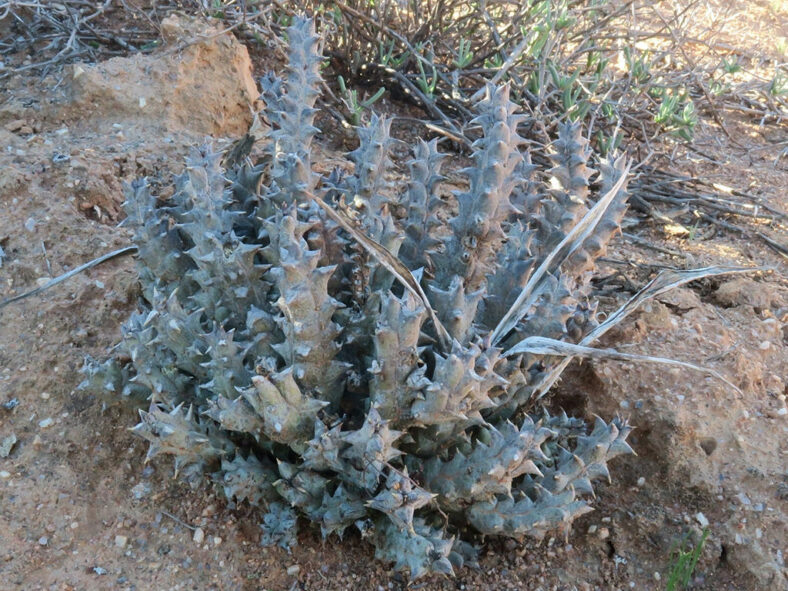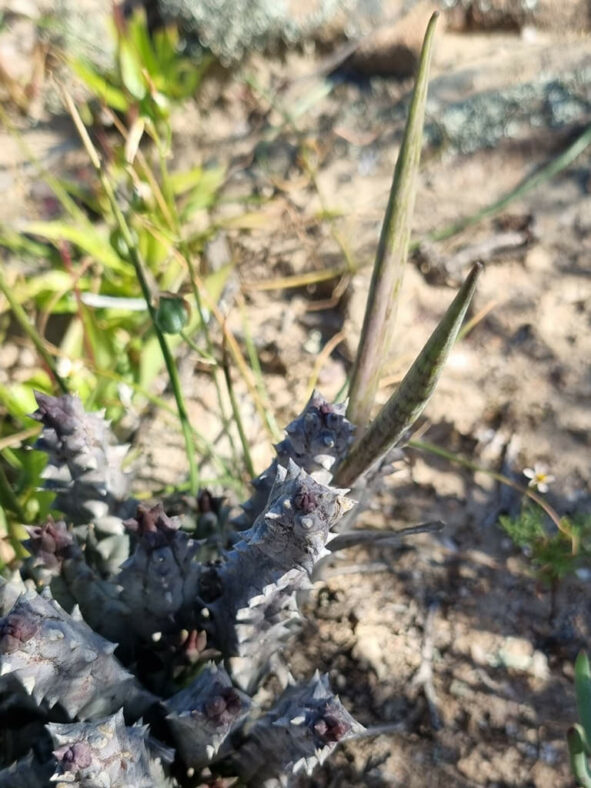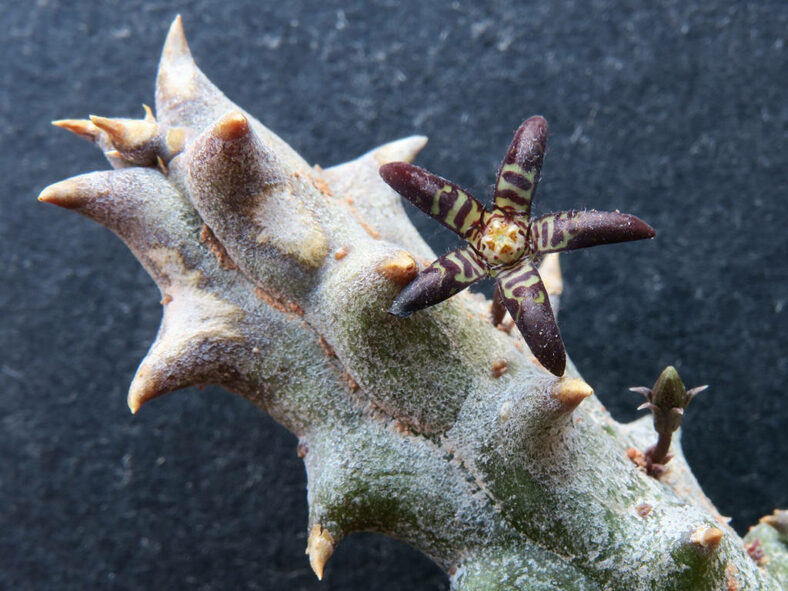Quaqua parviflora is a charming plant that grows in clumps and produces exquisite, small flowers. It was first described by Francis Masson in 1797 as Stapelia parviflora.
Scientific Name
Quaqua parviflora (Masson) Bruyns
Synonym(s)
Caralluma parviflora, Ceropegia parvioriflora, Piaranthus parviflorus, Quaqua parviflora subsp. parviflora, Stapelia parviflora
Scientific Classification
Family: Apocynaceae
Subfamily: Asclepiadoideae
Tribe: Ceropegieae
Subtribe: Stapeliinae
Genus: Quaqua
Etymology
The specific epithet "parviflora" (pronounced par-VEE-flor-uh) means "having small flowers" and refers to the flower size of this species.
Origin
Quaqua parviflora native to South Africa. The subspecies Quaqua parviflora subsp. parviflora is relatively common in Namaqualand from Moedverloor and Kotzesrus through Bitterfontein and Wallekraal to Anenous. It typically grows on gneissic soils or firm red coastal sand.
Description
Quaqua parviflora is a small succulent that forms a clump of stems with conical tubercles joined near the base into four angles along the stem. The stems can be either short and erect or quite long and partly scandent when the plant is grown in the shade. They are grey-green to purplish-green and can grow up to 12 inches (30 cm) long and 1 inch (2.5 cm) thick. The tubercles are straight or curved back, each tipped with a yellowish, pointed tooth, and can measure up to 0.25 inches (0.6 cm) in length. The young stems wear a short, velvety covering over their initially green skin.
In the fall, Quaqua parviflora produces inflorescences of 1 to 3 flowers that usually open successively towards the tips of stems. The flowers can reach a diameter of 0.5 inches (1.2 cm). The corolla lobes are narrow, spreading to slightly reflexed, and have margins with slender, scattered cilia. They are pale green, yellow, or whitish with transverse bars or spots that range from purple-black to red. Sometimes, the lobe tips are solid purple, brown, or green. The outer corona lobes are dark purple to reddish, becoming white towards the base, while the inner ones are whitish to reddish, often with a dark purple dorsal patch towards the base.

How to Grow and Care for Quaqua parviflora
Light: Quaqua parviflora prefers full sun but benefits from light shade on the hottest summer days. Indoors, place the plant near the brightest window in your home, as it will stretch if it does not receive enough sunlight. Avoid abruptly moving a plant adapted to lower light levels to full sun to prevent sunburn.
Soil: Use a commercial potting soil mix for succulents or prepare your own by mixing 50-70% mineral grit, such as coarse sand, pumice, or perlite.
Temperature: The plant thrives in warm outdoor environments with low to moderate humidity. It does not like winter cold and should remain relatively dry and warm during its dormancy. Quaqua parviflora grows best in USDA Plant Hardiness Zones 11a to 11b, with average minimum winter temperatures ranging from 40 to 50 °F (4.4 to 10 °C).
Watering: It has typical watering needs for a succulent. During the growing season, from spring to fall, water the plant thoroughly and allow the soil to dry between waterings. When it goes dormant in winter, it needs almost no water, about once a month.
Fertilizing: To keep the plant healthy and thriving, fertilizing is a good idea. Feed it with water-soluble fertilizer diluted to half the recommended strength, but only when the plant is actively growing.
Repotting: Repot Quaqua parviflora in spring, just before the growing season. It has shallow roots and does not require a lot of soil to grow. Always pick a container with drainage holes.
Propagation: The best way to propagate this succulent is from stem cuttings. To ensure good rooting, take cuttings during the growing season. The plant is also easy to start from seeds in spring.
Learn more at How to Grow and Care for Stapeliads.
Toxicity of Quaqua parviflora
Quaqua parviflora has no reported toxic effects, so it is safe to grow around kids and pets.
Links
- Back to genus Quaqua
- Succupedia: Browse succulents by Scientific Name, Common Name, Genus, Family, USDA Hardiness Zone, Origin, or cacti by Genus
Photo Gallery
Click on a photo to see a larger version.


